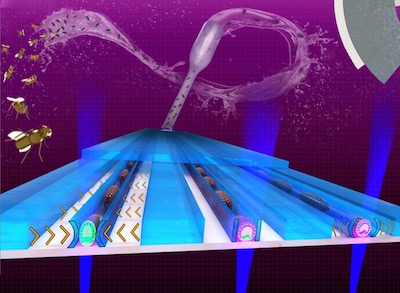Collaborators’ creation reveals how mechanical forces control genes
Biology and engineering merge in mesofluidics
Ben Panko
Apr 18, 2019

Source: Lab on a Chip, Royal Society of Chemistry
This small mesofluidic device automatically aligns, immobilizes, compresses, images and recovers hundreds of live fruit fly embryos to show more precisely how mechanical forces can control gene expression.
Carnegie Mellon University researchers have developed a device they believe is “a new milestone” in studying how mechanical forces influence gene expression in fruit fly embryos. The work was featured this month on the cover of the journal Lab on a Chip, the editors of which labeled the research “in the top 10 percent of innovation and impact.”
The complex dance in the DNA that causes a single cell to develop into a complex, multicellular organism is a key component of developmental biology. Understanding this dance could help prevent developmental problems and enable regeneration of damaged tissue. For decades, researchers have mapped the sequence and location of gene expression during development. But, recently, French biophysicist Emmanuel Farge discovered that squeezing a fruit fly embryo could change its gene expression.
“It’s like that scene in a movie where you hit a broken TV and suddenly it works,” said author Ardon Shorr, a science communications specialist who recently completed his doctoral degree in biological sciences at Carnegie Mellon. “I was blown away.”
To Shorr, this discovery meant learning that biology has many channels of communication. It’s not just genes and proteins that carry information, but also mechanical force. If scientists can learn to listen to that conversation and understand how it goes wrong, he said, they could treat mechanical disorders of aging or understand why astronauts deprived of mechanical force come back with so many health problems.
There’s a lot we can't learn from individual cells; we need the full complexity of whole organisms.
Utku Sönmez, Ph.D. student, Mechanical Engineering, Carnegie Mellon University
While Farge’s discovery was exciting, it was hard for researchers to understand what it could mean because it was hard to observe in numbers large enough for findings to be significant. The 2003 paper by Farge used a glass slide to squeeze a few fruit fly embryos at a time. "If we could scale this up by a factor of 100, that would let us ask some new and interesting questions for the first time," Shorr said.
This led to a collaboration between Shorr and Utku Sönmez, a Ph.D. student in mechanical engineering with experience designing microfluidic devices. Their work was supervised by Jonathan Minden, professor of biological sciences, and Philip LeDuc, professor of mechanical engineering, biomedical engineering, computational biology and biological sciences.
Microfluidic devices are typically the size of a dime and can precisely engage hundreds of cells, Sönmez explains. “But there's a lot we can't learn from individual cells, we need the full complexity of whole organisms. So, the challenge was to bring all the benefits of microfluidics to larger fruit fly embryos.” The team calls this “mesofluidics,” a medium-sized twist on the field.
After six design iterations and years of testing, the team unveiled a small device on a glass slide that met all of their goals: it automatically aligns, immobilizes, compresses, images and recovers hundreds of live fruit fly embryos. Using this device, they extended Farge’s work to hundreds of embryos and were able to showmore precisely how mechanical forces can control gene expression.
“Farge is like a celebrity to me, and I didn’t know what he would think of this project,” said Shorr. “But before we could e-mail him, he reached out to us and congratulated us on the results. It’s a great feeling to build on work that I admire and to find that we have something to add to the conversation.” Sönmez agrees, quoting Isaac Newton: “If I have seen further, it is by standing on the shoulders of giants.”
This research was funded by the Air Force Office of Scientific Research, the Office of Naval Research, the Pennsylvania Department of Health and the Turkish Education Agency.
This article originally appeared in Mellon College of Science News of 2019.
Media contacts:
College of Engineering
Lisa Kulick, lkulick@andrew.cmu.edu
Mellon College of Science
Jocelyn Duffy, jhduffy@cmu.edu